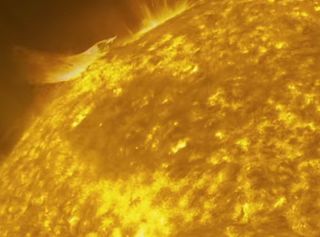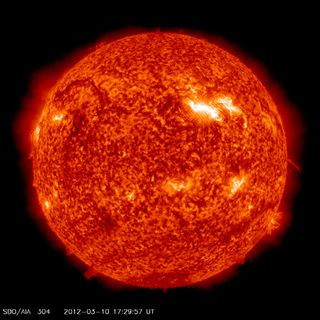Tiny 'Nanoflares' May Solve Sun Mystery
Small "nanoflares" erupting from the sun might be the key to unlocking a cosmic mystery, according to a new study.
Scientists have found that the sun's outer atmosphere, or corona, can reach temperatures 1,000 times higher than those at the surface of the star, but solar physicists previously had no explanation for why this temperature discrepancy is so great. Now, researchers think the relatively tiny flares may be the "smoking gun" that explains this mysterious cosmic occurrence.
The new study provides the first direct proof that nanoflares keep the sun's corona at a temperature of millions of degrees, far hotter than the sun's visible surface, which is about 6,000 degrees Kelvin (10,000 degrees Fahrenheit). [The Biggest Solar Flares of 2014: Photos]

"The nanoflare model has been around for a while," said Jeffrey Brosius, a solar physicist at NASA's Goddard Space Flight Center in Greenbelt, Maryland "With better instrumentation, we were hoping to find the evidence that was predicted by the model."
Nanoflares happen because of huge magnetic fields located throughout the sun's corona. These loops are anchored in the photosphere, the sun's visible surface, but move around due to turbulence in the photosphere. Sometimes the field lines cross, and they become twisted and tangled.
When this happens in the presence of plasma, current sheets form, and the "stress" builds until the magnetic field "breaks," releasing lots of energy very quickly. This kind of crossing of magnetic fields can happen thousands of times a second over the whole solar surface, and this transfers energy to the plasma in the corona. That energy transfer could explain the corona's extra heat.
Earlier evidence for this, though, was indirect. While other models didn't fit observations, the model based on nanoflares was still missing a piece of the puzzle. That missing evidence came from the Extreme Ultraviolet Normal Incidence Spectrograph mission, which picked up light emitted by a special kind of ionized iron, called Fe XIX. (The Roman numeral describes how highly ionized the iron is, and thus the temperature of the plasma, which was about 8.9 million degrees Kelvin, or about 16 million degrees Fahrenheit.)
Get the Space.com Newsletter
Breaking space news, the latest updates on rocket launches, skywatching events and more!
The EUNIS instruments also spotted another form of ionized iron, Fe XII, which occurs at a temperature of 1.6 million degrees Kelvin, or about 2.9 million degrees Fahrenheit.
The ratio of the two ions showed that the corona is heated by short bursts, rather than a continuous input of energy, because that ratio -- the brightness of Fe XIX relative to its cousin Fe XII -- would only occur under certain physical conditions. "One of the predictions of the nanoflare model is there should be fairly widespread but faint emission of plasma at about 10 million Kelvin [18 million degrees Fahrenheit]," Brosius told Space.com.

One reason for this doubt is that the emission from the ionized ironwas so hard to see because it was faint. Another is that the corona is "optically thin," meaning that at some wavelengths, it's basically translucent, like stained glass. So the nanoflares, many occurring simultaneously and overlapping, tend to "wash out."
The study appears in the August issue of the Astrophysical Journal.
Follow us @Spacedotcom, Facebook and Google+. Original article on Space.com.
Join our Space Forums to keep talking space on the latest missions, night sky and more! And if you have a news tip, correction or comment, let us know at: community@space.com.

Jesse Emspak is a freelance journalist who has contributed to several publications, including Space.com, Scientific American, New Scientist, Smithsonian.com and Undark. He focuses on physics and cool technologies but has been known to write about the odder stories of human health and science as it relates to culture. Jesse has a Master of Arts from the University of California, Berkeley School of Journalism, and a Bachelor of Arts from the University of Rochester. Jesse spent years covering finance and cut his teeth at local newspapers, working local politics and police beats. Jesse likes to stay active and holds a fourth degree black belt in Karate, which just means he now knows how much he has to learn and the importance of good teaching.